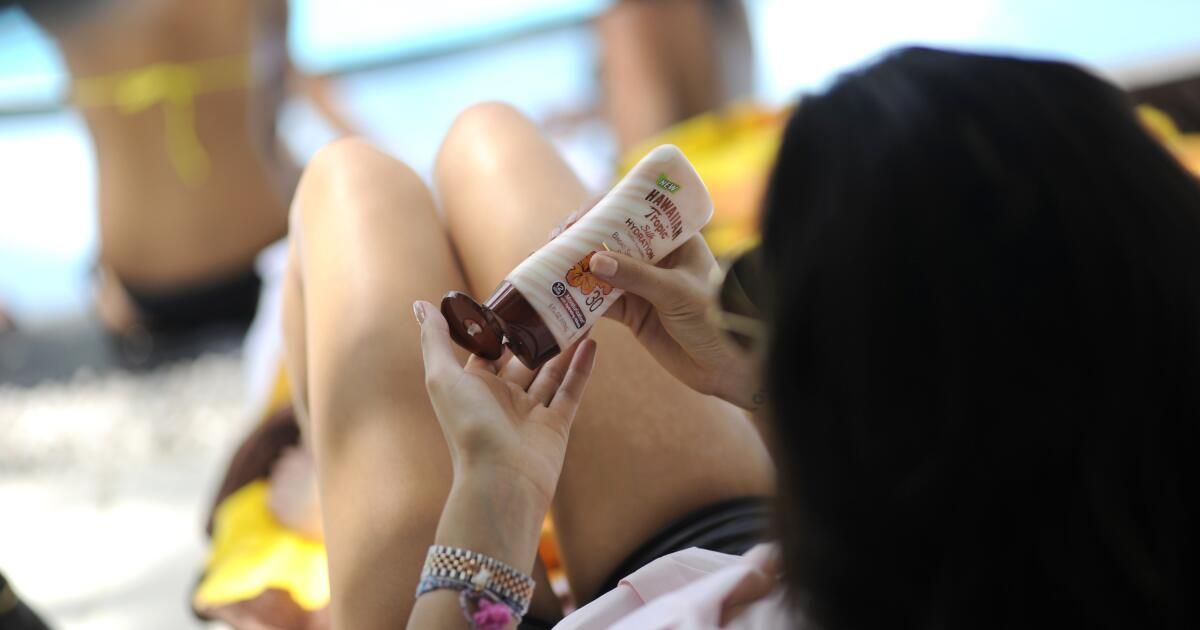Sunscreen skeptics beware: the sun's ultraviolet rays are coming for you, and you're making their job easier.
Summer is here, which means more time in the sun and more exposure to the ultraviolet radiation it emits. Longer wavelength ultraviolet A rays can reach beneath the skin's surface and cause premature aging. Shorter wavelength ultraviolet B rays affect the outermost layers of the skin and cause sunburn and tanning. (A third type of rays, ultraviolet C, is intercepted by Earth's protective ozone layer.)
Both UVA and UVB rays damage the DNA of skin cells and cause mutations. These mutations can accumulate over time and cause tumor growth. The more UV exposure you have, the higher your risk, according to the Skin Cancer Foundation.
Basal cell carcinoma is the most common type of skin cancer in the United States, followed by squamous cell carcinoma. About 5.4 million of these cancers combined are diagnosed each year and cause between 2,000 and 8,000 deaths, according to the American Cancer Society.
Melanoma of the skin is rarer and more deadly, affecting about 100,640 Americans this year and causing 8,290 deaths, according to the National Cancer Institute.
Sunscreens can protect you from these malignancies in two ways. Chemical sunscreens contain ingredients like avobenzone that absorb ultraviolet rays. Mineral sunscreens rely on zinc oxide or titanium dioxide to block or reflect rays. Either way, solar radiation cannot penetrate the skin and corrupt its DNA.
Here are 10 sunscreen myths you can't afford to fall for:
Myth 1: As long as you don't get sunburned, you're safe.
Reality: You don't have to get sunburned to put your skin at risk. UV exposure will compromise the DNA of unprotected skin (even if your skin appears normal to the naked eye) and the effects are cumulative, said Dr. Henry Lim, a photodermatologist at Henry Ford Health in Detroit, who studies the effect of sunlight on the skin.
“Any time the sun damages the skin, with or without a sunburn reaction, there is some damage that the skin would have to repair,” Lim said. “If that subclinical damage continues frequently enough for a long enough period of time, the skin's ability to fully repair all that DNA damage will be compromised.”
Myth 2: Your body needs vitamin D and sunscreen will prevent you from getting it.
Reality: It only takes a small amount of sun exposure to produce all the vitamin D your body needs. A study of white people in the Boston area found that 5 to 10 minutes of sun on the face, arms, and legs two to three times a week during the summer months was enough to produce sufficient amounts of vitamin D.
Even if you apply sunscreen, you'll still get that minimal amount of sun exposure, Lim said. “When we use sunscreen, we don't apply enough of it,” she said. “It's just human nature”.
Dr. Anne Chapas, a Manhattan dermatologist and clinical instructor at Mt. Sinai Medical Center, advises patients concerned about their vitamin D levels to protect their skin and look for the nutrient in foods or take supplements.
“You need vitamin D to be healthy, but there are several ways to get it,” he said.
Myth 3: The chemicals in sunscreen can cause cancer.
Reality: The active ingredients in sunscreens sold in the U.S. are regulated by the Food and Drug Administration, which has determined them to be safe and effective. The National Academies add that “sunscreen use is not linked to higher rates of any type of cancer.”
In fact, the opposite is true, Chapas said: “If you're trying not to get cancer, then use sunscreen.”
Los Angeles Dodgers first baseman Freddie Freeman sprays sunscreen on his face. Dermatologists recommend spraying it on your hand and then applying it to your face.
(Robert Gauthier/Los Angeles Times)
Myth 4: It is not necessary to use sunscreen when the UV index is low.
Reality: The UV index primarily measures UVB rays, which Lim calls “the sunburn spectrum.” Even if UVB rays are low, you should still protect yourself from UVA rays.
“As long as there is light, there will be enough UVA rays” to induce tanning, cause wrinkles and contribute to skin cancer risk, Lim said.
Chapas agreed. “Even on cloudy days, about 80% of the sun's rays get through and you can still get sun damage,” he said.
Myth 5: You don't need sunscreen if you have dark skin.
Reality: People of any complexion can suffer sun damage and skin cancer. In fact, “skin cancer in patients with darker skin tones is often diagnosed at later stages, when it is more difficult to treat,” said Dr. Seemal Desai, president of the American Academy of Dermatology.
Chapas added that since darker skin tends to produce melanin in response to sun exposure, it can fade more easily than lighter skin.
Myth 6: Mineral-based sunscreens are safer than chemical sunscreens.
Reality: Both types are safe to use, but there are fewer unknowns with mineral sunscreens since they don't absorb into the skin, Lim said.
Chapas said that's one of the reasons she prefers mineral sunscreens. He also appreciates their versatility, as they can be applied on top of makeup or moisturizer. “The challenge is that some of these formulations have a whitish undertone, so you have to find one that works with your complexion,” he said.
Myth 7: You can protect yourself from the sun by achieving a “basic tan.”
Reality: A tan may provide some protection, but it is less than the equivalent of an SPF 5, Lim said. That's not enough to make sunscreen unnecessary.
Additionally, a tan in itself is a sign of sun damage. “When our skin is exposed to UV light, it stimulates the production of melanin to prevent more UV rays from entering the skin and damaging the underlying skin cells,” Chapas said. “A tan is not healthy. A tan is actually your body trying to protect itself.”
Myth 8: Astaxanthin, an antioxidant, will protect you from UV rays and act as an “internal sunscreen.”
Reality: There are two ways antioxidants reduce the biological damage that occurs with sun exposure, Lim said. When UVA rays damage DNA, they do so by causing oxidative DNA damage, and antioxidants can help minimize this. Additionally, when visible light interacts with the skin, it can cause cells to produce a type of destructive molecule called reactive oxygen species. Antioxidants can also help counteract this process.
Including antioxidants in a sun protection regimen makes sense, but they can't do the job alone. “There are no pills that act as effectively as sunscreen,” Chapas said.
If you want to take an antioxidant to reduce sun damage, astaxanthin is not necessarily the best choice, Lim and Chapas agreed. The product that Chapas recommends is from Heliocare.
Myth 9: Chemicals in sunscreen enter the bloodstream and build up over time.
Reality: There are no long-term studies on the blood of people who use sunscreen regularly, so there is no data to say whether this is true or false. However, the chemicals are excreted in urine, which is a sign that they do not remain in the body, Lim said.
People who are wary of chemical sunscreens can opt for mineral sunscreens, she said.
Myth 10: You can keep sun damage at bay by wearing a good hat.
Reality: A wide-brimmed hat will certainly help protect you from the sun. This is especially true for people who are bald or have thinning hair, since “we don't have good sunscreens for hairy areas,” Chapas said.
However, a hat will only block UV rays coming from above. Without sunscreen, you will still be vulnerable to rays that reflect off water, sand, or urban surfaces like a sidewalk and reach your skin from below. (This is also why you need sunscreen even if you're in the shade.)
“There are multiple actions we need to take,” Lim said. “Each of them is useful, but it's not as good as when you put it all together.”












